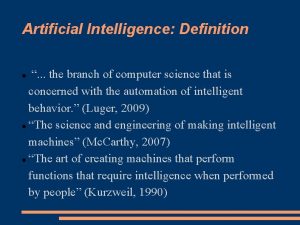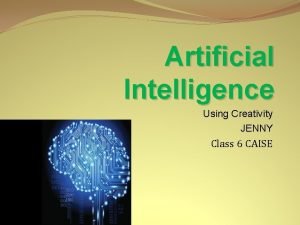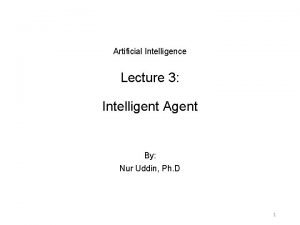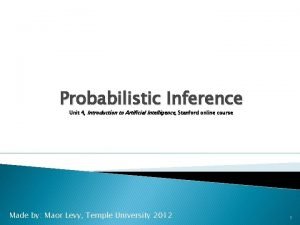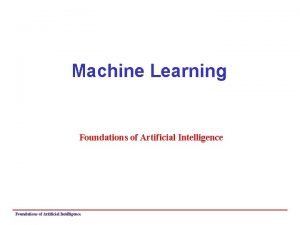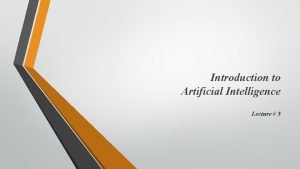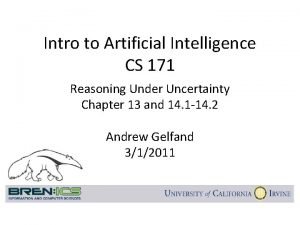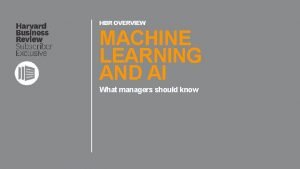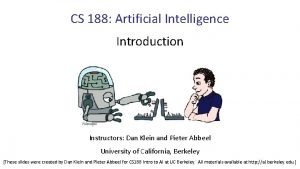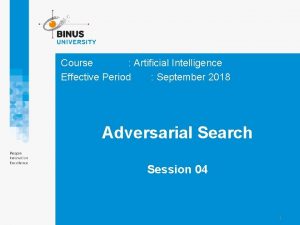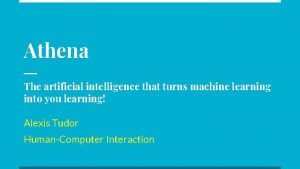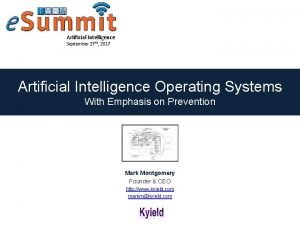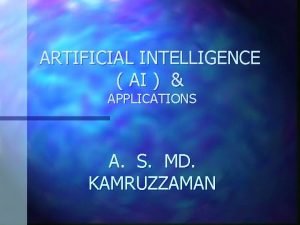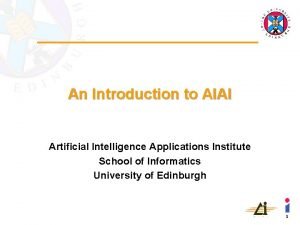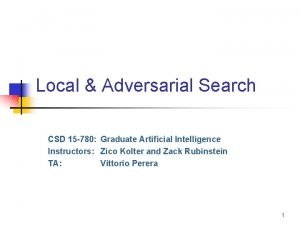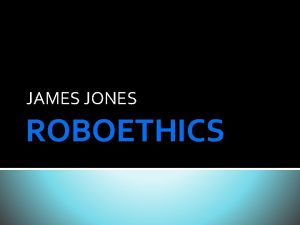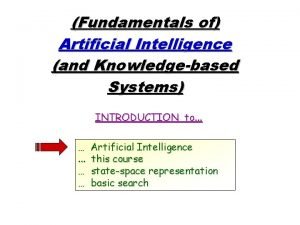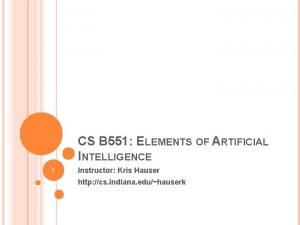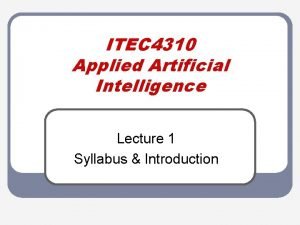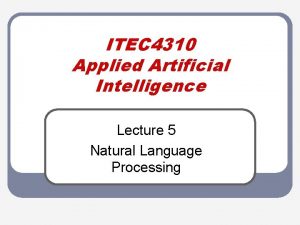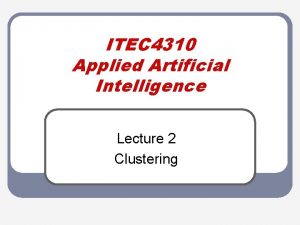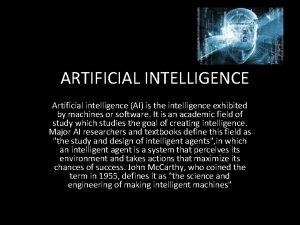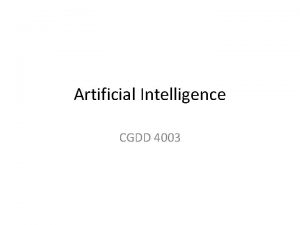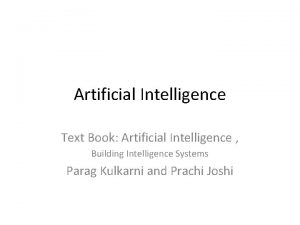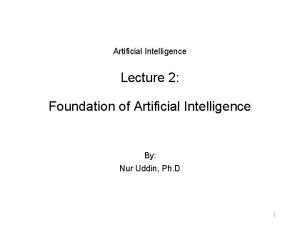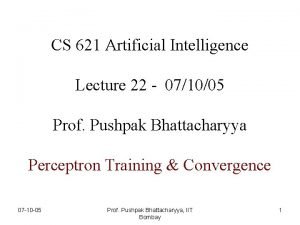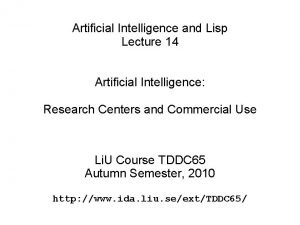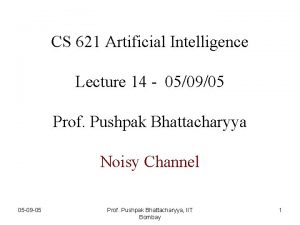ITEC 4310 Applied Artificial Intelligence Lecture 6 Computer















































- Slides: 47

ITEC 4310 Applied Artificial Intelligence Lecture 6 Computer Vision and Autonomous Vehicles

Attribution l The following slides are taken from Charles R. Dyer Emeritus Professor of Computer Sciences and Biostatistics and Medical Informatics University of Wisconsin, Madison http: //pages. cs. wisc. edu/~dyer/

Face Detection and Recognition Reading: Chapter 18. 10

Face Detection Problem • Scan window over image • Classify window as either: • Face • Non-face Face Window Classifier Non-face

Face Detection: Motivation • Automatic camera focus http: //cdn. conversations. nokia. com. s 3. amazonaws. com/wp-content/uploads/2013/09/Nokia-Pro-Camera-auto-focus_half-press. jpg

Face Detection: Motivation • Automatic camera focus • Easier photo tagging • First step in any face recognition algorithm http: //images. fastcompany. com/upload/camo 1. jpg

Face Detection: Challenges • Large face shape and appearance variation • Scale and pose (yaw, roll, pitch) variation • Background clutter • Occlusion • hair • glasses • hat • Lighting • Expression • Makeup

The Viola-Jones Real-Time Face Detector P. Viola and M. Jones, 2004 Challenges: • Each image contains 10, 000 – 50, 000 locations and scales where a face may occur • Faces are rare: 0 - 50 per image • > 1, 000 times as many non-faces as faces • Want a very small # of false positives: <10 -6

Use Machine Learning to Create a 2 Classifier • Training Data (grayscale) • 5, 000 faces (frontal) • 108 non-faces • Faces are normalized • Scale, translation • Many variations • Across individuals • Illumination • Pose (rotation both in plane and out)

Use Classifier at All Locations and Scales

Building a Classifier • Compute lots of very simple features • Efficiently choose the best features • Each feature is used to define a “weak classifier” • Combine weak classifiers into an ensemble classifier based on boosting • Learn multiple ensemble classifiers and “cascade” them together to improve classification accuracy and speed

Computing Features • At each position and scale, use a sub-image (“window”) of size 24 x 24 • Compute multiple candidate features for each window • Want to rapidly compute these features

Local Features What are local features trying to capture? The local appearance in a region of the image David G. Lowe, "Distinctive image features from scale-invariant keypoints, " International Journal of Computer Vision, 60, 2 (2004)

What Types of Features? • Use domain knowledge • The eye region is darker than the forehead or the upper cheeks • The nose bridge region is brighter than the eyes • The mouth is darker than the chin • Encoding • Location and size: eyes, nose bridge, mouth, etc. • Value: darker vs. lighter

Features • 4 feature types (similar to “Haar wavelets”): Two-rectangle Three-rectangle Four-rectangle Value = ∑ (pixels in white area) - ∑ (pixels in black area)

Huge Number of Features 160, 000 features for each window!

Computing Features Efficiently: The Integral Image • Intermediate representation of the image • Sum of all pixels above and to left of (x, y) in image i: • Computed in one pass over the image: ii(x, y) = i(x, y) + ii(x-1, y) + ii(x, y-1) − ii(x-1, y-1)

Using the Integral Image x (0, 0) s(x, y) = s(x, y-1) + i(x, y) ii(x, y) = ii(x-1, y) + s(x, y) y (x, y) • With the integral image representation, we can compute the value of any rectangular sum in constant time • For example, the integral sum in rectangle D is computed as: ii(4) + ii(1) – ii(2) – ii(3)


Results

Profile Detection

Profile Features

Face Alignment and Landmark Localization Goal of face alignment: automatically align a face (usually nonrigidly) to a canonical reference http: //www. mathworks. com/matlabcentral/fx_files/32704/4/icaam. jpg Goal of face landmark localization: automatically locate face landmarks of interests http: //homes. cs. washington. edu/~neeraj/projects/face-parts/images/teaser. png

Face Image Parsing Given an input face image, automatically segment the face into its constituent parts Smith, Zhang, Brandt, Lin, and Yang, Exemplar-Based Face Parsing, CVPR 2013

Face Image Parsing: Results Input Soft segments + Hard segments Ground truth

Face Image Parsing: Results Input Soft segments + Hard segments Ground truth

Face Detection and Recognition Reading: Chapter 18. 10 and, optionally, “Face Recognition using Eigenfaces” by M. Turk and A. Pentland

F a c e R e c o g n Queryimage face query database

Face Verification Problem • Face Verification (1: 1 matching) • Face Recognition (1: N matching)

Application: Access Control www. viisage. com www. visionics. com

B i o m e t r i c

Pay by Selfie Amazon, Mastercard, Alibaba developing methods

Application: Video Surveillance Face Scan at Airports www. facesnap. de


i. Photo • Can be trained to recognize pets! http: //www. maclife. com/article/news/iphotos_faces_recognizes_cats

i. Photo • Things i. Photo thinks are faces

Why is Face Recognition Hard? The many faces of Madonna

Recognition should be Invariant to • • Lighting variation Head pose variation Different expressions Beards, disguises Glasses, occlusion Aging, weight gain …

Intra-class Variability • Faces with intra-subject variations in pose, illumination, expression, accessories, color, occlusions, and brightness

Inter-class Similarity • Different people may have very similar appearance www. marykateandashley. com Twins news. bbc. co. uk/hi/english/in_depth/americas/2000/us_el ections Father and son

B l u r r e d F a c

B l u r r e d F a c Michael Jordan, Woody Allen, Goldie Hawn, Bill Clinton, Tom Hanks, Saddam Hussein, Elvis Presley, Jay Leno, Dustin Hoffman, Prince Charles, Cher, and Richard Nixon. The average recognition rate at this resolution is one-half.

U p s i d e D o w n The “Margaret Thatcher Illusion”, by Peter Thompson

F a c e R e c o g n i Face Detection Feature Extraction Image Window Classification Feature Vector Face Identity

Image as a Feature Vector x 2 x 1 x 3 • Consider an n-pixel image to be a point in an nn dimensional “image space, ” x ∈ �� • Each pixel value is a coordinate of x • Preprocess images so faces are cropped and (roughly) aligned (position, orientation, and scale)

A Rapid Survey II (Lecture 1) l Edge Detection § https: //www. slideshare. net/simrangori/basicsof-edge-detection l Computer Vision § https: //www. slideshare. net/stevencharlesmitch ell/introduction-to-computer-vision l Autonomous Cars § https: //www. slideshare. net/Shantanu. Vashisht ha 1/autonomous-vehicles-70049669

Readings and Assignments
 Rg 4310/2018
Rg 4310/2018 Artificial intelligence is a branch of computer science
Artificial intelligence is a branch of computer science Expert system architecture in ai
Expert system architecture in ai What is state space search in ai
What is state space search in ai Searching for solutions in artificial intelligence
Searching for solutions in artificial intelligence 15-780 graduate artificial intelligence
15-780 graduate artificial intelligence Knowledge manipulation in ai
Knowledge manipulation in ai Types of knowledge in ai
Types of knowledge in ai American association for artificial intelligence 17 mar
American association for artificial intelligence 17 mar Kecerdasan kepemimpinan
Kecerdasan kepemimpinan Artificial intelligence assessment
Artificial intelligence assessment Math and artificial intelligence
Math and artificial intelligence Peas description in ai
Peas description in ai 15-780 graduate artificial intelligence
15-780 graduate artificial intelligence Machine learning xkcd
Machine learning xkcd Inference rules for fuzzy propositions
Inference rules for fuzzy propositions Cse 571 asu
Cse 571 asu 15-780 graduate artificial intelligence
15-780 graduate artificial intelligence Informed search and uninformed search in ai
Informed search and uninformed search in ai What is artificial intelligence class 6
What is artificial intelligence class 6 Augmented grammar in artificial intelligence
Augmented grammar in artificial intelligence Omniscience in artificial intelligence
Omniscience in artificial intelligence Int 404
Int 404 Artificial intelligence chapter 3
Artificial intelligence chapter 3 Partitioned semantic network in artificial intelligence
Partitioned semantic network in artificial intelligence A* vs ao*
A* vs ao* Artificial intelligence thesis proposals
Artificial intelligence thesis proposals Rule based deduction system in artificial intelligence
Rule based deduction system in artificial intelligence Inference by enumeration in artificial intelligence
Inference by enumeration in artificial intelligence Learning in ai
Learning in ai Ucs
Ucs Pxdes expert system
Pxdes expert system Optimal decisions in games in artificial intelligence
Optimal decisions in games in artificial intelligence Andrew ng hbr
Andrew ng hbr Cs188 artificial intelligence
Cs188 artificial intelligence Optimal decisions in games in artificial intelligence
Optimal decisions in games in artificial intelligence Athena machine learning
Athena machine learning Artificial intelligence operating system
Artificial intelligence operating system Inference in first order logic
Inference in first order logic Artificial intelligence applications institute
Artificial intelligence applications institute Conclusion of artificial intelligence
Conclusion of artificial intelligence Artificial intelligence applications institute
Artificial intelligence applications institute The blind search algorithms are.
The blind search algorithms are. 15-780 graduate artificial intelligence
15-780 graduate artificial intelligence Ethics of artificial intelligence
Ethics of artificial intelligence Part picking robot peas
Part picking robot peas Fundamentals of artificial intelligence
Fundamentals of artificial intelligence Csci-b 551 elements of artificial intelligence
Csci-b 551 elements of artificial intelligence

